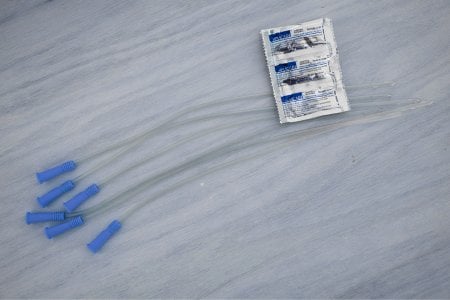Benefits of Using Catheters with an Attached Bag

Have you heard about advanced intermittent catheter options like catheters with attached drain bags? For people who need to intermittently self-catheterize, a catheter with an attached bag can offer a convenient, all-in-one solution. Whether you need it for managing urinary retention or post-void residuals (PVR), closed system catheters and catheter kits can allow you to discreetly and easily self-cath without needing to carry multiple, separate components, like gloves and wipes.
Let’s go over the advantages and potential benefits of using catheters with an attached bag for urine drainage.
What Are the Benefits of Catheters with an Attached Bag?
Keep in mind that every individual is different with a unique anatomy, needs, and preferences.
Here are some of the potential benefits of using a catheter with an attached bag:
1. Easy All-in-One Design
With an attached urine collection bag, you no longer have to worry about carrying all your separate catheter supplies, such as lubricant, a drain bag, gloves, and antiseptic wipes. Using a catheter with an attached bag and insertion supplies can simplify your whole process while reducing the risk of infection by keeping your hands from directly touching the catheter tube that goes inside your body to drain your bladder.
Also, when the drain bag is pre-connected, you don’t have to worry about leakage while catheterizing.
2. Discreet and Portable
Catheters with attached bags can sometimes come in more discreet, compact packaging, depending on the catheter brand. A discreet catheter design can allow for more privacy and flexibility when you’re catheterizing away from home.
3. Hygienic and Sterile
Sterile closed system catheters are designed with hygiene in mind. Many feature a no-touch insertion technique, which may help minimize the risk of contamination during the catheterization process. The all-in-one design further reduces the chances of bacteria being introduced, as users don’t have to handle or connect additional components like a separate urine drain bag or catheter lubricant.
4. Ready-to-Use for Convenience and Quickness
Many catheters with attached bags come pre-lubricated with a hydrophilic coating, meaning they are ready to use immediately after opening. This eliminates the need for additional supplies like lubricant or water to activate the catheter, making it a convenient option for users who need to catheterize while on the go. If you’re nervous about taking too much time to catheterize when you’re away from home, a ready-to-use catheter like a hydrophilic or pre-lubricated catheter with an attached bag may be a good option to consider, depending on your insurance plan’s catheter coverage.
5. Great for Traveling and Being On-the-Go
Catheters with attached bags are especially useful for individuals who are frequently on the go, living an active lifestyle, or traveling regularly. If you catheterize in less predictable settings like a public bathroom, a pre-attached drain bag on your catheter can allow for catheterization without needing to find a restroom equipped with a toilet or urinal. You can simply find a private place to catheterize and dispose of your supplies later.
Answering FAQs About Catheters with an Attached Bag
What conditions may lead to needing to use catheters with attached bags?
This catheter type can be used by anyone who has been prescribed intermittent catheterization to manage their urinary conditions, such as bladder retention, urinary incontinence, post-void residual volume, neurogenic bladder, and other similar issues.
However, closed system catheters with their own drainage bags are sometimes preferred by people with limited mobility, limited hand or finger function, and people who use wheelchairs. Frequent travelers also sometimes prefer this catheter type. It comes down to what works best for you as an individual.
Are catheters with attached bags similar to Foley catheters with drain bags?
While both catheter types work to drain the bladder, intermittent catheters with bags are different from Foley catheters, and it’s important to understand the difference.
Intermittent catheters are designed for one-time use and are inserted into the bladder only when necessary to drain urine. A doctor or another qualified healthcare professional will prescribe how often it’s needed to intermittently catheterize based on an individual’s condition and treatment plan. Once the bladder is emptied, the intermittent catheter is removed and thrown away. An intermittent catheter with an attached drain bag combines the catheter and the drain bag into a single, all-in-one option. This catheter type will primarily be used by individuals who catheterize multiple times a day but do not need continuous drainage all day and night. Intermittent catheters can sometimes provide more independence and discretion, allowing you to catheterize as needed without being connected to a drainage system all the time.
A Foley catheter, or indwelling catheter, is for long-term use and continuous bladder drainage. Typically, a healthcare professional inserts a Foley catheter, which is then placed with a small balloon that inflates inside the bladder. Foley catheters are connected to a larger external urine drainage bag worn on the leg, hung from a wheelchair, or positioned beside a bed. It’s important to note that a Foley catheter does require frequent care and monitoring to avoid infection.
The choice between an intermittent catheter with an attached bag and a Foley catheter with a drain bag or leg bag will depend on several factors, including the user’s medical condition, lifestyle, and how often they need to empty their bladder. If you prefer an option that allows for greater mobility, privacy, and independence, an intermittent catheter, such as a pre-lubricated closed system catheter kit, may be right for you.
What French size options of closed system catheters are available?
We offer one of the widest varieties of catheter options from all major manufacturers and catheter brands. Depending on the brand and type, there are French sizes (diameter of the catheter tube) from as small as pediatric options for children up to the larger adult sizes of 18 and 20 Fr. The most common and average catheter sizes are typically readily available, but again, this depends on the brand and the type.
Our Catheter Specialists can help you find the right product based on your needed size, your healthcare provider’s prescription, and your health insurance’s catheter coverage.
Considerations When Choosing Your Catheter Supplies
When you’re considering a catheter with an attached bag, consider factors like your individual needs, comfort, mobility, the needed French size, and ease of use.
While a closed system catheter kit is ideal for some people, it may not work for everyone. That’s why we offer customers the freedom to try and choose what will work best for them. Get started by requesting free samples, and our friendly team will reach out to discuss your options.
As always, consult your prescribing healthcare provider to ensure you use the right catheter for your needs. Our specialists are ready to help you with all your product questions. Contact our team to get started!
Disclaimer: The information provided in this blog is intended for general informational purposes only and should not be considered a substitute for professional medical advice, diagnosis, or treatment.
Request Free Catheter Samples
Related Articles





